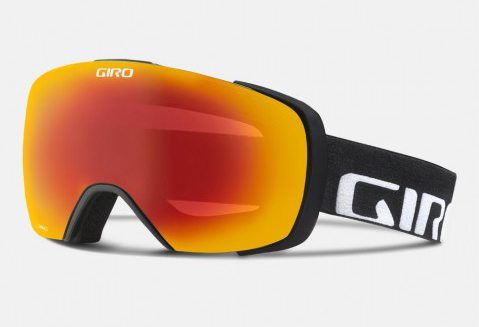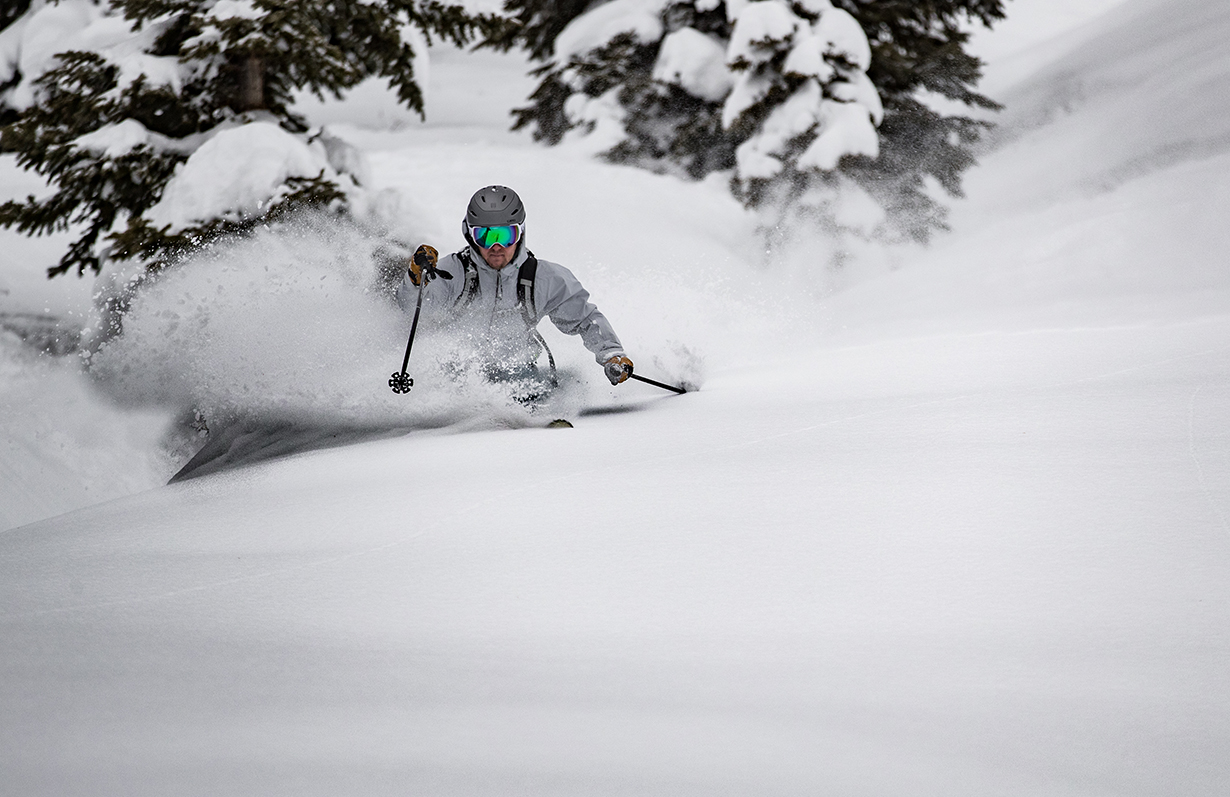
Giro Contact Goggle
Frame Color: White Wordmark
Lens: Loden Green (26% VLT) and Yellow Boost (62% VLT)
Features:
- EXV – Expansion View Technology
- SNAPSHOT – Magnetic Interchange Lens System
- Triple-layer face foam with micro-fleece facing
- Anti-Fog Coating
- Spherical Lenses by ZEISS
MSRP:
- $240 with two lenses
- $300 with two lenses (one polarized)
Days Tested: ~40
Test Locations: Porters Ski Area & Craigieburn Valley, NZArapahoe Basin, Breckenridge, Vail & Backcountry, Colorado; Mt. Baker, WA; Jackson Hole, WY
Intro
(Note: Click here if you want to go straight to our reviews of the Giro Zone MIPS helmet.)
The Contact is Giro’s top-of-the-line model. It distinguishes itself from many other goggles on the market by featuring a lens that is held in place by magnets. We’ve long been a fan of this feature, previously only found on the Anon M1/M2/M3 goggle series, and the M2 has won our Blister Best Of award for several years now.
Last year, Giro introduced the original version of the Contact, which Cy Whitling reviewed. While Cy’s overall review was positive, the Contact’s locking mechanism and soft frame left it trailing behind the Anon M2. Cy’s review also only covered a single lens, the Persimmon Boost lens, which left us wondering how some of the other lens options perform?
Since then, I’ve been skiing in a slightly updated version of the Contact that features a tweaked frame and lens retention mechanism, with good results.
Fit
The Contact’s soft frame lends itself to an excellent and adaptable fit. While the shape isn’t a perfect fit for my particular face, I still am able to get an excellent fit as the frame conformed to my face quite well. The Contact feels noticeably more comfortable than the Smith IO goggles that I’ve used in the past. So while it’s always best to try goggles on before purchase, I felt that, overall, the Giro Contact has a fit that would suit a variety of faces quite comfortably thanks to the soft frame.
Lens Swapping
The lens on the Giro Contact is not only held in place by magnets, it’s also locked in place by a small latch. A button on the top-right of the goggle releases the latch and actually pushes the lens out, making it easy to grab. While Cy mentions he had issues accessing the button on the original Contact with a gloved hand (especially with his helmet on), I never really had any issues, and found it quite easy to rip the lens and replace it with my other lens on the updated version.

Cy also notes that the soft frame of the Contact can cause the lens to pop and release when lifting the goggles off your face with one hand. I also found this to be true. However, when using both hands to lift the goggles off my face, the lens stayed secure, and the flexible frame didn’t present any problems. After about two weeks, I got used to using two hands, and never really thought about it again.
Giro Loden Green 26 (26% VLT — Visible Light Transmission)
Giro describes the Loden Green 26 lens as being designed for partly cloudy days. The overall look of the lens is very sharp — a mirrored green finish that looks great and really pops (see the above photo). The performance of the lens is also excellent. We get a lot of bluebird days in Colorado, but in early winter, any north-facing slopes are still in the shade. With a dark lens, visibility can be poor on these slopes, especially toward the end of the day or if clouds roll in. With the Loden Green lens, in the shade and light clouds, the terrain variations were easily visible. And, in full sun on south-facing terrain, I never felt like I needed a darker lens.
I’ve used Smith IO goggles for several years, and have struggled to find the right lens for these conditions. I typically found myself waffling between the Green Sol-X lens (which I find to be a bit too dark for north facing slopes in early winter), and the Platinum Mirror lens, which I find to be a bit too bright for sunny spring days.
Giro’s Loden Green lens, despite having the same 26% VLT as the Smith’s Platinum Mirror lens is much better on sunny spring days, while also never leaving me wishing for more visibility on north-facing terrain in early winter, even in the presence of light clouds.
In short, the Loden Green lens is excellent.
Giro Yellow Boost Lens (62% VLT)
When the clouds get a bit thicker, you’ll want another lens, which brings me to Giro’s Yellow Boost lens. This lens is a full-on cloudy and stormy day lens. In flat light in the alpine, it’s just as good as any yellow lens I’ve used, while also being slightly more versatile when the sky gets a bit brighter.
I’ve A/B-ed the Yellow Boost lens to Smith’s Blue Sensor Mirror. While the Blue Sensor Mirror is a bit more versatile on sunny days, the Yellow Boost lens is a bit better when the light is flat and it gets difficult to read the terrain.
What about a lens for when the day starts out sunny but transitions to stormy and overcast (or vice versa)? The great part about the Giro Contact is that I don’t need a single (subpar) lens for both conditions. The two excellent lenses, the Loden Green, and Yellow Boost are extremely easy to swap on the chairlift, and they complement each other perfectly. Most days I’d just bring one lens, but if conditions were drastically changing, the other lens easily fits into my jacket pocket.
Helmet Compatibility
I only have Giro helmets at my disposal, since Giro helmets have always fit me the best. The Contact fits seamlessly with the Giro Zone MIPS helmet. The slight but consistent gap between the goggle frame and helmet allows for proper venting and excellent integration, while the goggle foam covered the gap and kept my forehead warm. The Contact also fit just as well with the Giro Montane and Giro S5 helmets.
Field of Vision
The overall field of vision of the Giro Contact is quite good. It’s a bit more open than the Smith IO goggles. Being picky, in the middle of the lens on either side of the nose, the lens frame protrudes a bit more into the field of vision than the IO’s. While I can’t say it’s ever been a problem, it is a bit more noticeable than with the IO’s.
Fogging (or lack thereof)
While Cy mentions in his review that the venting on the Contact isn’t on par with other goggles that he’s used, I’d say that this is actually a benefit. The Contact has vents on the top, but not the bottom. The lack of vents on the bottom of the Contact means that moist air won’t rise up and into vents which can lead to interior fogging (which happens with my Smith IOs).
While I got interior fogging when getting snow inside, I found that the excellent integration with the vents on the Giro Zone MIPS helmet do a good job of clearing the lens when moving. And while standing in the chairlift line after skiing a lap, I can easily pop the lens out and wipe it dry, and the moisture and fogging is no more. This is much easier than trying to get snow and moisture out from the inside of the Smith IOs, whose lens isn’t as easy to pop out of the frame; I often end up getting even more snow in the goggles.
The lack of bottom vents on the Contact also means that there is less wind and air penetration compared to the Smith IO goggle, keeping my face warmer. It also means that I don’t tear up when skiing fast on extremely cold days, which I do in the IOs.
Durability
While I didn’t have a problem with normal fogging, I did have an issue with one of the Giro Contact lenses. On an extremely wet and rainy day at Jackson, I did experience some rain leaking in between the interior and outer lens of the lens assembly. The trapped water would slosh around inside the lens assembly, and created fogging. The water was trapped all day, even after placing the lens by a fireplace for about an hour. This was the only time I had water trapped inside the lens (and the only time where I was skiing in the rain).
Bottom Line
The Giro Contact has a good field of vision, is difficult to fog on the interior, has excellent lens options, integrates very well with Giro’s helmets, and swapping lenses is extremely quick and easy. The soft, flexible frame conforms well to one’s face, and is very comfortable.
In my opinion, the updated Giro Contact is right up there with the Anon M2 goggle. So if you’re in the market for a magnetic lens swap goggle, I’d suggest purchasing the pair that’s most comfortable for you, or the one that integrates best with your helmet.

I realize this review is nearly a year old, but I’ll still give it a go…
I’m in the market for a new pair of goggles. Almost no goggle review I’ve read online (and I’ve read a bunch!) addresses the relative fit of the nose opening. I didn’t realize that there can be a very substantial difference until I recently tried on about 10 different pairs of goggles at one place. I have a slightly-larger-than-normal schnozz, and two goggles that were not on my original short list had really comfortable/larger nose openings, particularly near the top of the opening where it converges to a point: the Oakley Airbrake XL and the Spy Doom. In comparison, all the other goggles I tried (Smith I/O, I/O7, I/OX, Anon M2 and M3, etc) felt too snug, with a noticeable increase in breathing resistance…not major, but noticeable to the point where I greatly preferred the more nasally open goggles.
So, any thoughts on how the nose opening of these Contacts might compare relatively, perhaps to the Smith I/O series? I’m quite keen on these but I can’t find them locally to try on, so any input would be greatly appreciated. Thanks!
Sorry, D. I’ve only had experience with the Smith I/Os, which would probably fit different than the rest of the Smith series.